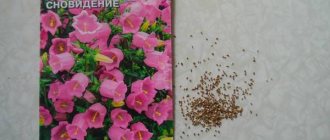Author: Elena N. https://floristics.info/ru/index.php?option=com_contact&view=contact&id=19 Category: Garden plants Published: February 10, 2019Last edits: January 20, 2021
- When to plant
- Growing conditions
- How and when to collect seeds
- Cosmos bipinnatus
Cosmea is a flower that has been familiar to us since childhood. It’s just that when we saw cosmos bushes near the entrance, in parks, squares and vacant lots, we didn’t know the name of this plant. Thanks to its undemanding conditions and care, as well as its resistance to adverse environmental factors, the Mexican aster has become widespread throughout the world.
Read our article and you will find out:
- what types and varieties of cosmos are most popular in culture;
- how to grow cosmos seedlings;
- when to transplant seedlings into a flower garden;
- how to care for cosmos during the season:
- How perennial plant varieties overwinter.
Planting and caring for cosmos
- Planting: sowing seeds in the ground - in early spring, as soon as the snow melts, or before winter; sowing seeds for seedlings - in March or April, transplanting seedlings into the garden - from mid-May to early June.
- Flowering: from mid-June to September.
- Lighting: bright sunlight.
- Soil: any, but loose, well-drained, moderately fertile, slightly acidic soil is preferable.
- Watering: weekly and abundantly - 4-5 buckets for each bush.
- Feeding: three times per season with complete mineral fertilizer: before the formation of buds, during the budding period and before the start of flowering. Foliar feeding is also welcome.
- Reproduction: seed.
- Pests: For young plants that have not yet matured, slugs and snails pose a danger.
- Diseases: the plant is very resistant to any infections.
Read more about growing cosmos below.
flowers (lat. Cosmos) , or cosmos , or Mexican aster belong to the genus of perennial and annual herbs of the Asteraceae, or Asteraceae, family, numbering more than twenty species. The name comes from the Greek word kosmeo and translated means “decoration”. The tropics and subtropics of America are considered the homeland of cosmos; most species of cosmos grow in Mexico. In our climate, only three species of this genus are grown - two annual cosmos and one perennial.
Detailed information about the cosmos plant
People call cosmos simply, space. Moreover, both in Russia and in the plant’s homeland, in South America, where climatic conditions create an ideal environment for the flower, and in North America. But the botanical name of this annual or perennial plant has never sounded like that.
This flower from the Astrov family - it’s funny that the name also has a reference to stars and distant galaxies - has more than four dozen varieties, although only half of them are grown in garden conditions. However, these are only registered varieties! All cosmos are united by a similar external description.
You should familiarize yourself with it before planting cosmos to grow from seeds:
- Numerous shoots up to 1.5 meters in height, all rich green;
- The leafy structure of the greenery, the leaves are thin and numerous;
- Large paniculate-type inflorescences with a diameter of up to 12 centimeters;
- Tubular buds with large yellow pollen that attract pollinators.
Botanical description
The cosmos plant reaches a height of 50 to 150 cm. Its stems are thin, flexible, erect and branched. The leaves are opposite, twice dissected, openwork, graceful. Inflorescences-baskets, similar to daisies, up to 12 cm in diameter, grow singly or are collected in loose corymbose panicles. The middle flowers in the baskets are small, tubular, yellowish, and the reed flowers are large, purple, pink, red, white, golden yellow.
- Chinese juniper Spartan - what must be added to the planting hole, what care is required?
You can often read or hear the expressions “terry cosmos flower” or “growing terry cosmos,” but this does not mean that we are talking about any particular species, it’s just that in recent years, breeders have developed double varieties of plant species that have long been cultivated. The fruit of cosmos is a dark yellow, gray or brown achene. Cosmos seeds remain viable for two to three years.
The use of cosmos in landscape design
There are about 30 different types of cosmos, differing in height, shades of inflorescences, and their shape.
Due to this diversity, growing plants from seeds is widely used in landscape design to create an imitation of a meadow or a village garden. Cosmos go well with phlox, marigolds, and daisies.
Tall varieties (up to 150 cm) are planted next to the fence, creating a corridor of flowers. If necessary, they are cut to give the desired shape.
Low species are used for borders.
Recently, cosmos have begun to be grown by sowing seeds in outdoor flowerpots and containers, and balcony boxes.
Growing cosmos from seeds
How to sow seeds
The cosmos flower is propagated by seeds, both by sowing directly in open ground and by seedlings. When to plant cosmos seeds in open ground? A cosmos flowerbed is sown in early spring, after the snow has melted. The seeds are scattered on the surface of the soil in nests, three to four pieces every 30-40 cm, and lightly smacked with the palm of your hand so that the planting depth is no more than one centimeter.
Flowering of cosmos when sown without seedlings begins in July-early August. You can sow cosmos in open ground in late autumn, before winter. In addition, cosmos reproduces well by self-sowing in the fall; all you have to do in the spring is to thin out the densely sprouted shoots.
Seedling care
Growing cosmos in seedlings gives more reliable and faster results. When to sow cosmos seedlings? In March or April. Photosensitive cosmos seeds sown on top of the substrate are lightly pressed into the soil without sprinkling, moistened and the seed is covered with film or glass. The container with the seed is kept in a bright place. If the temperature for seed germination is between 18-20 ºC, sprouts will appear in a week or two.
Dense seedlings need to be thinned out so that the distance between seedlings is 10-15 cm; for this purpose, picking can be done. Pickled seedlings are grown at a lower temperature - 16-18 ºC. If you don’t want to bother with picking seedlings, you can immediately sow two or three seeds in separate cups.
Seed germination and picking seedlings
The first shoots appear 10–14 days after sowing. At the initial stage, seedlings do not require care. After the formation of a pair of leaves, the seedlings are planted in separate cups or pots.
When 7–8 leaves form on the sprouts, pinch the crown. This technique will stimulate the formation of side shoots and subsequently increase the number of flower buds formed on the bush.
After the formation of a pair of leaves from common containers, the seedlings need to be transplanted into individual pots
Planting cosmos
When to plant
Cosmos planting is carried out in early June, when the return frosts have passed and the seedlings will stretch up to 6 cm. Planting in mid-May is acceptable if you are sure that the cold will not return. Find an open sunny area for the cosmos, protected from the wind, with moderately fertile, well-drained, slightly acidic soil. Too fertile soil promotes the lush growth of greenery, but, alas, the quality and intensity of flowering suffers from this.
- Tips for fertilizing strawberry bushes
How to plant
So, in mid-May or early June, when the weather finally gets warm, prepare shallow holes in the garden according to the 30x30 or 35x35 pattern if you are going to plant tall varieties, and water them. Then plant the seedlings in the holes, dig them in and water them again. Do not forget that tall varieties of cosmos may require support, so in advance, when planting seedlings, dig in slats or rods around which you will tie an adult bush. When the cosmos reaches a height of 50 cm, pinch the tops of the shoots so that the plant bushes better. Cosmos grown from seedlings blooms in June or mid-July.
Preparing for sowing in open ground
This method of sowing is much simpler than growing using seedlings. However, in this case the flowers will appear a little later. No special preparation is required before planting; it consists of three steps.
Step 1. Select and prepare seeds
As planting material, you can choose seeds of different varieties and create a group bright flower garden. The seeds have an elongated shape and medium size; one gram of planting material contains about 200 of them. Preliminary stratification and soaking in potassium permanganate are not required. The material can be sown immediately in dry form.
Important! Elongated seeds are usually placed vertically in the hole. However, this planting method is not recommended for cosmos.
Snow-white cosmos flowers
Step 2. Find a location
Cosmea feels good next to fruit trees. Fragrant flowers attract butterflies, which help pollinate the entire garden. In addition, the future habitat of the plant can be selected according to the following recommendations:
- Presence of sun and absence of strong winds. Cosmea requires a well-lit, draft-free place.
- Part of a hedge. This variety of garden crops is capable of growing, so it is ideal for a hedge. Cosmos can be planted as a stand-alone “living fence” or as an addition to gaps in a hedge of other plants.
- Neighborhood with other flowers. Cosmos gets along well with other plant species. However, to create an aesthetic flower garden, tall cosmos must be planted behind the other flowers.
- Indoor flower garden. Low-growing varieties can be planted in a flowerpot and placed on the balcony. If the loggia is closed, the cosmos will delight you with its inflorescences until the onset of severe frosts.
- Curb support. Low-growing varieties of cosmos can be planted next to borders to further decorate and frame them.
In some cases, cosmos is used as insect bait. So, it is planted in the garden to attract lacewings . And those, in turn, contribute to the destruction of mealyworms , thrips and aphids .
Cosmos flowers of the Double Click variety, reminiscent of a garden rose flower
Step 3. Prepare the soil for planting.
Any universal primer is suitable for cosmos. But before planting it needs to be prepared:
- drain too dense soil with sand or wood shavings;
- loosen the soil well to provide the seeds with access to oxygen and water;
- feed with organic fertilizer and lightly moisten.
It must be taken into account that the plant cannot be over-fed. Otherwise, it will begin to actively develop stems and leaves, and there will simply be no strength left for the formation and maturation of flowers.
Important! If the soil is not fertile enough, it can be fertilized with complex mineral compounds. A mixture of liquid cow manure and superphosphate works well. The procedure is carried out once a season.
Any universal soil is suitable for sowing cosmos seeds.
Cosmos care
Growing conditions
Planting and caring for cosmos is not burdensome even for beginners in floriculture. Watering cosmos is carried out once a week, and it should be plentiful - four to five buckets of water should be poured under each bush. After watering, loosen the soil in the area and remove weeds until the cosmos becomes a mature, strong plant.
Feeding cosmos with fertilizers for flowering plants is carried out three times a season: before budding, during it and at the beginning of flowering. For more abundant flowering, you can perform foliar feeding - spraying the leaves with Bud, but when fertilizing cosmos, remember that moderation is needed in everything. Remove fading flowers promptly.
If the cosmos in the flowerbed has grown greatly, you can cut it, this will not stop flowering, and the bushes will become compact and more attractive. That, in fact, is all you need to know about growing cosmos flowers.
Pests and diseases
Cosmea is so immune to diseases and pests that it is practically not affected by them. Only slugs and snails pose a threat, and only until the plant has come into full bloom. You will have to deal with shellfish by collecting them manually. Place bowls of beer around the area and collect gastropods that come crawling to feast on it from time to time.
Wintering
For most of Russia, it will be relevant to take additional measures to protect the dormant plant in winter. Namely:
- If the frosts are already severe and there is little snow, do not be lazy to throw the already fallen snow on the dormant shoots. A layer of snow will provide good protection from frost.
- Before the snow falls and the nights are already getting cold, it won’t hurt to sprinkle the wintering shoots with stove ash. Ash will not only warm the plants, but also fertilize the soil and protect against pests in the spring.
Cosmea after flowering
How and when to collect seeds
Perennial cosmos propagates by tubers and cuttings, and annual cosmos in the garden after initial planting will propagate by self-sowing for several years - from three to five. If you want to get cosmos seeds, leave the largest buds on the bush for the fruits to ripen, and to prevent the ripened seeds from spilling on the ground, put gauze bags on the flower heads. As soon as the seeds darken, it is time to remove them. However, you should know that cosmos plant is cross-pollinated, so the seeds do not retain varietal characteristics, and it makes sense to simply buy seed from well-established manufacturing companies.
Perennial cosmos in winter
When the perennial cosmos blooms, it is better to trim it, leaving only 15 cm of stems on the bush. For the winter, the cosmos is covered with spruce branches.
- How to plant daffodils in the ground correctly
How to collect seeds
If you want to save your favorite variety and collect seeds from it, then follow a couple of simple tips:
Select the largest seed baskets and cover them with gauze until fully ripe. The seeds are light and can be blown away by the wind.
Already ripe seeds are brown in color, should be dry and simply separate from the basket.
Seeds should be stored in a cloth or paper bag in a dry, dark place with good ventilation. When properly stored, the seeds remain viable for about 3 years.
Types and varieties
Three types of cosmos are grown in culture - two annual and one perennial. True, these species, thanks to breeders, have many varieties and hybrids. So, we present to you annual species of cosmos:
Cosmos bipinnatus
An annual herbaceous plant from the mountainous regions of Mexico with erect, densely branched stems ranging from 80 to 150 cm in height. As the name implies, the foliage of this species is dissected into thread-like lobes, so it looks like dill leaves. Baskets from 7 to 10 cm in diameter grow singly or are collected in large corymbose inflorescences. The colors of the marginal flowers are white, red, pink, purple, and the tubular flowers form a small yellow disc in the middle of the basket. Cosmea bipinnate blooms profusely and gives good self-seeding. In cultivation since 1799 and today it is the most popular species in floriculture. Varieties:
- Dazzler – the blooming inflorescences have a bright red hue, but after a while they turn crimson;
- Purity - cosmos white as snow, with flexible stems;
- low-growing cosmos of the Sonata series, which includes the Sonata Pink Blush variety - pink cosmos with a red rim around the middle.
Cosmos sulphureus
Distributed in Latin America, this is a very heat-loving species with branched, erect, pubescent stems up to one and a half meters high. The leaves are twice and thrice dissected into wide pinnate lanceolate lobes, pointed towards the apexes. Reed flowers are orange or golden yellow, tubular flowers are yellow with protruding dark anthers with orange ends. In culture since 1799. Varieties:
- Bilbo – orange cosmos with semi-double inflorescences;
- Crest Lemon – lemon-yellow cosmos growing up to 50 cm;
- Diablo - this cultivar has fiery red inflorescences.
Blood red cosmos (Cosmos atrosanguineus)
Perennial cosmos is represented by such a species as blood-red cosmos, brought to us from the same Mexico. Sometimes this species is called black cosmos, because its red color is very dark, and its velvety flowers smell like chocolate. The leaves of this species are complex, consisting of an unpaired number of leaflets. Since red cosmos is an exceptionally heat-loving plant, it is recommended to grow it in pots that can be brought indoors for the winter. If you decide to grow blood-red cosmos in open ground, you will have to cover it for the winter.
Recently, terry cosmos has become increasingly popular. Most often, the following varieties attract the interest of gardeners:
- Brightness - abundantly flowering bushes with bright double inflorescences;
- Antiquity is a unique variety of compact cosmos with flowers that gradually change their original Burgundy wine color to salmon with a bronze tint;
- Double click rose bon-bon is a variety with very large double pink flowers that last a long time when cut.
When to sow cosmos seedlings
Seedlings are propagated from low-growing forms and varieties with large flowers. Seeds are sown in containers with a diameter of about eight centimeters, 2–3 pieces each. Sowing is carried out in greenhouses or in a room in April.
Important! When growing seedlings, it is important to accurately determine the time of sowing, since the seedlings should not outgrow. If overgrown, weak, thinned specimens are obtained. Not only will they not bloom earlier than those sown in open ground, but their inflorescences will also be much smaller.
The seeds are tamped into the soil without covering them with substrate, since they germinate only in the light. The seedlings hatch in one to two weeks at a crop temperature of 18–25 degrees. Seedlings are kept in the light and watered moderately.
In the phase of 5–7 leaves, seedlings are pinched to improve branching. True, this can slow down the beginning of flowering, but the bushes turn out to be lush and branchy.
Seedlings are placed in the beds at the end of May. The gaps between plants are 30–35 cm. Cosmeas can withstand transplantation well. When placed densely, the seedlings grow frail, with thin, lodging stems. Cosmos bloom 2.5–3 months after sowing:
- plants sown in the ground - in July;
- grown through seedlings - in July.
Flowering lasts until frost (late October). For good flowering, plants need open sun for 8–10 hours a day.
Features of planting seeds: timing, preparatory work
Sowing cosmos seeds in open ground is usually done in late April - early May. When using the seedling method, the seeds are sown in prepared containers in early April, and the grown seedlings are transferred to a permanent planting site at the end of May.
Cosmea seeds
In both cases, cosmos will delight you with its flowering already in July. In order to achieve this result, it is important to follow a few simple rules:
- Do not bury the seeds when planting.
- Provide young plants with the necessary amount of sunlight.
- Thin out dense shoots in a timely manner. But you can see what Ipomoea seeds look like in this article.
In addition to traditional planting in the spring, cosmos can be planted before winter.
This article will help you figure out how to grow marigolds from seeds.
Which varieties of Pansies are the most common among gardeners can be seen in this article.
You can see what Osteospermum flowers look like in this article here: https://2gazon.ru/ozelenenie/derevo-i-kust/osteospermum-osobennosti-vyrashhivaniya-i-uxoda.html











